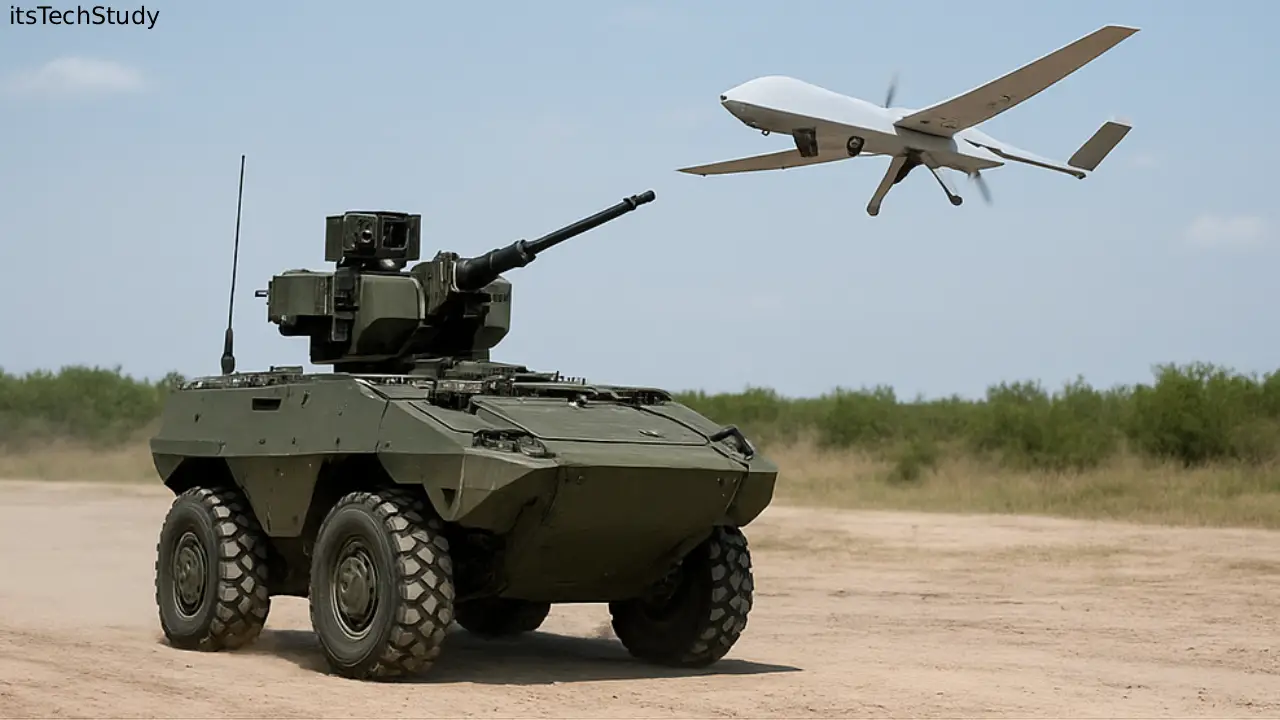Autonomous systems are reshaping modern defense by reducing risk to personnel, expanding situational awareness, and accelerating decision cycles, but they also introduce hard questions about reliability, ethics, interoperability, and command accountability that militaries must address with clear policy and rigorous testing. The U.S. Department of Defense’s updated directive on autonomy in weapons systems and international initiatives on responsible military AI underscore how governance, testing, and human judgment remain central as AI-enabled platforms proliferate across air, land, sea, and space domains.
Why Autonomous Systems Matter Now
For decades, “unmanned” platforms were niche, tethered to remote pilots and limited autonomy; today, AI-driven systems act as frontline assets that extend reach, manage risk, and operate in contested environments, including GPS– or comms-denied scenarios. Market trajectories and multinational defense exercises show accelerating adoption of robotic and autonomous systems (RAS), from drone swarms and loitering munitions to unmanned ground and maritime platforms, with procurement models evolving to onboard innovation faster and standardization efforts focusing on interoperability and ethics. Nations are also aligning around voluntary principles, such as the Political Declaration on Responsible Military Use of AI, to guide development and deployment while maintaining human responsibility over use of force.
The State of Play: Air, Land, Sea, and Multi-Domain
Autonomous air systems-from reconnaissance drones to loitering munitions-lead adoption due to tactical flexibility and lower risk profiles, with swarming concepts enabling coverage, redundancy, and saturation tactics in contested zones. On land, unmanned ground vehicles support logistics, perimeter security, and reconnaissance in complex terrain; at sea, unmanned surface and underwater vehicles extend anti-submarine warfare, mine countermeasures, and persistent ISR without crew fatigue. Live exercises and industry events increasingly feature integrated demos where multi-domain autonomous nodes share data, collaborate on tasking, and hand off targets across platforms under human-supervised command-and-control frameworks.
Procurement Is Changing: Speed, Standards, and Sovereignty
Defense ministries are retooling acquisition to keep pace with agile AI development cycles, pilot rapid pathways, and bring non-traditional vendors into programs that historically took years to contract. Countries are simultaneously building sovereign capability-engineering, testing, and integration hubs-to ensure security of supply, reduce dependencies, and tailor autonomy to national doctrine and environments. Coalition efforts are moving toward shared standards for robotic interoperability and governance so allied systems can safely operate together without introducing unintended behaviors or brittle dependencies.
Loitering Munitions and Swarms: A Case Study in Momentum
Loitering munitions have become emblematic of autonomy’s battlefield impact: blending ISR and precision strike, these systems can orbit and engage when conditions are optimal, with expendable variants dominating current demand. Forecasts point to strong growth-driven by electronic warfare resilience, cooperative tactics, and AI-enabled target recognition-while recoverable variants gain interest for cost efficiency and flexible reuse in ISR-centric missions. As swarm communications, cooperative navigation, and real-time threat assessment improve, doctrine and countermeasures must evolve to address massed, adaptive, and distributed effects from relatively low-cost autonomous assets.
Policy and Ethics: Guardrails for Responsible Use
Updated policy emphasizes human responsibility, reliability, traceability, and governability for AI-enabled systems, with mandates for testing, legal review, and the capacity to deactivate systems demonstrating unintended behavior. International declarations on responsible military AI aim to create common expectations for safety, discrimination, and accountability, though implementation requires rigorous engineering practices, robust validation, and continuous operator training. The thrust is clear: autonomy should enhance human decision-making, not replace it, and must be aligned with the law of war and clear rules of engagement across the lifecycle of design, deployment, and operations.
What’s Driving Adoption
- Risk reduction by removing personnel from high-threat roles like mine clearance, EW-contested ISR, and high-altitude surveillance.
- Cost-effectiveness and scalability of expendable autonomous systems relative to crewed platforms and traditional standoff munitions.
- Operational tempo and resilience, with swarms and distributed C2 enabling missions under degraded communications or GPS interference.
- Rapid procurement frameworks and innovation hubs that shorten the distance from prototype to fielding for AI-native systems.
Key Challenges to Solve
- Assurance and reliability under edge cases, adversarial conditions, and complex urban terrain remain hard problems that demand extensive testing and red-teaming.
- Interoperability across allied systems, data links, and C2 software is critical to coalition operations and must be validated in realistic environments.
- Ethical governance, transparency, and human oversight require clear doctrine, interfaces that support understanding and control, and auditable logs.
- Counter-autonomy is rising; resilient autonomy must account for jamming, spoofing, deception, and adaptive adversary tactics.
Technology Pillars Under the Hood
- Perception and sensor fusion: multimodal sensing plus robust filtering for degraded or denied environments improves detection, classification, and navigation.
- Planning and control: decentralized, cooperative algorithms for swarming enable redundancy, task allocation, and collision avoidance with minimal bandwidth.
- Assured autonomy: formal methods, scenario-based testing, and fail-safe behaviors help ensure bounded operation and safe disengagement when anomalies emerge.
- Human-machine teaming: intuitive interfaces, mission-level control, and explainable behaviors support calibrated trust and faster, more accurate operator decisions.
Comparison Table: Loitering Munitions vs Swarm Systems
Pros and Cons: Autonomous Systems in Defense
Pros:
- Reduce risk to personnel in high-threat missions, from ISR in contested airspace to demining and maritime patrol.
- Increase persistence, coverage, and responsiveness with distributed, cooperative platforms.
- Potential cost efficiencies via expendable or reusable platforms and rapid iteration of AI capabilities.
- Enable operations under degraded GPS/comms with resilient autonomy and local decision loops.
Cons:
- Reliability, assurance, and predictability are challenging in complex or adversarial settings.
- Interoperability and standardization gaps can hinder coalition effectiveness and raise integration costs.
- Ethical, legal, and policy compliance demands rigorous oversight, documentation, and operator training.
- Counter-autonomy and EW raise the bar for secure, robust communications and control.
Emerging Trends to Watch
- Accelerating field demos: Conferences and exercises increasingly showcase cross-domain autonomy with realistic mission vignettes, speeding lessons learned into programs.
- Sovereign capability centers: National hubs for integration, testing, and deployment mature industrial bases and shorten upgrade cycles.
- International governance: Declarations and research bodies are shaping norms and best practices for AI-enabled targeting and decision support.
- Supply chain adaptation: Demand for sensors, secure compute, and resilient comms grows alongside software-first autonomy stacks.
Implementation Playbook: From Pilot to Program
- Define mission scope and guardrails. Specify operational envelopes, disengagement triggers, and human oversight levels aligned to doctrine and law of war.Choose modular architectures. Favor open interfaces for sensors, effectors, and C2 to future-proof interoperability and upgrades.
- Choose modular architectures. Favor open interfaces for sensors, effectors, and C2 to future-proof interoperability and upgrades.
- Validate at scale. Use synthetic environments, live trials, and adversarial testing to probe edge cases and EW resilience with auditable logs.
- Train for teaming. Develop operator skills for mission-level control, anomaly response, and cross-domain coordination under degraded comms.
- Plan counter-countermeasures. Incorporate EW-resistant links, deception detection, and fallback behaviors for contested environments.
- Iterate rapidly but safely. Leverage rapid acquisition and fieldable updates with strong configuration control and legal review gates.
Actionable Roadmap for Defense Programs
- Start small, scale thoughtfully: Pilot autonomy in non-lethal, high-utility roles (e.g., logistics and ISR) before expanding to complex missions.
- Invest in digital twins and simulation: Build scenario libraries for edge cases, EW stress, and urban complexity with traceable test artifacts.
- Standardize interfaces early: Adopt coalition-friendly data models and C2 protocols to ease joint operations and lifecycle upgrades.
- Institutionalize responsible AI: Align development with ethical principles, legal reviews, and disengagement capabilities from the outset.
- Prepare counter-autonomy playbooks: Integrate detection, EW hardening, and deception-resistant tactics across doctrine and training.
Strategic Outlook: 2025–2030
As defense budgets prioritize adaptable capabilities, autonomous platforms will proliferate in mixed fleets that pair crewed assets with uncrewed teammates to extend sensing, strike options, and survivability. Market forecasts suggest sustained growth in expendable effects and increasing sophistication in recoverable and reusable platforms, while policy frameworks mature to ensure transparency, reliability, and lawful use. The competitive edge will belong to forces that master assured autonomy under adversity, coalition interoperability, and human-machine teaming that is trusted, traceable, and tactically decisive.
Featured Comparison Table: Market and Policy Signals
Pros and Cons Snapshot
Pros:
- Force protection, persistent ISR, and cost-effective effects at scale.
- Faster OODA loops and mission resilience in contested environments.
Cons:
- Assurance, interoperability, and ethical compliance are non-trivial and ongoing efforts.
- Rising counter-autonomy pressures require continuous adaptation.
Conclusion
Autonomous systems are moving from supporting roles to central pillars of modern defense, offering persistence, scale, and risk reduction that crewed platforms alone cannot match, provided they are governed by rigorous testing, ethical guardrails, and human oversight. Programs that invest in assured autonomy, interoperable architectures, and realistic training-while aligning with international principles-will unlock decisive advantages across multi-domain operations in the decade ahead.
Frequently Asked Questions
Q1: What’s the difference between remotely piloted and autonomous military systems?
Ans: Remotely piloted systems rely on continuous human control for navigation and engagement, while autonomous systems execute tasks based on onboard decision-making within predefined constraints and with human judgment over use of force retained through doctrine, interfaces, and policy.
Q2: Why are loitering munitions getting so much attention?
Ans: They combine ISR and precision strike, can wait for optimal engagement windows, and are relatively cost-effective, with expendable types dominating the market and recoverable variants gaining traction for reusable ISR missions.
Q3: How is the ethics debate being handled in practice?
Ans: Policies such as DoD Directive 3000.09 require reliability testing, traceability, legal review, and the ability to disengage or deactivate on unintended behavior, while international declarations articulate responsible use principles and promote human accountability.
Q4: What are the biggest technical challenges for swarms?
Ans: Secure and resilient communication under EW, cooperative navigation in GPS-denied environments, real-time task allocation, and assured safety behaviors for dense, decentralized operations remain active research and engineering frontiers.
Q5: Will autonomous systems replace human decision-makers in targeting?
Ans: Current policy and research emphasize that autonomy should support, not replace, human judgment, with humans remaining responsible for use of force and with clear rules, interfaces, and procedures to maintain control.
Q6: How are allies ensuring their autonomous systems work together?
Ans: Through shared standards, joint exercises, and governance frameworks that harmonize interfaces, testing, and ethical protocols so coalition units can coordinate safely and effectively across missions.












No Comments Yet
Be the first to share your thoughts.
Leave a Comment